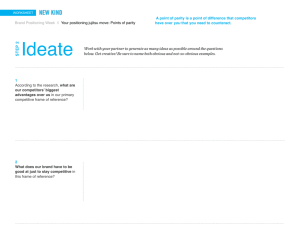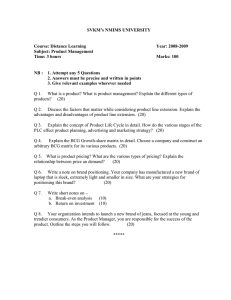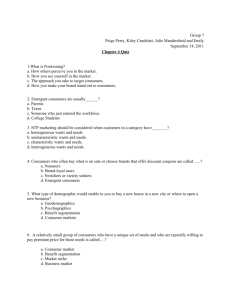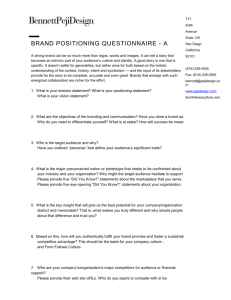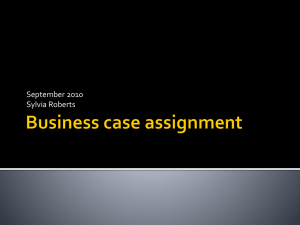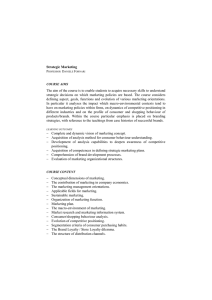5.BRAND POSITIONING
advertisement
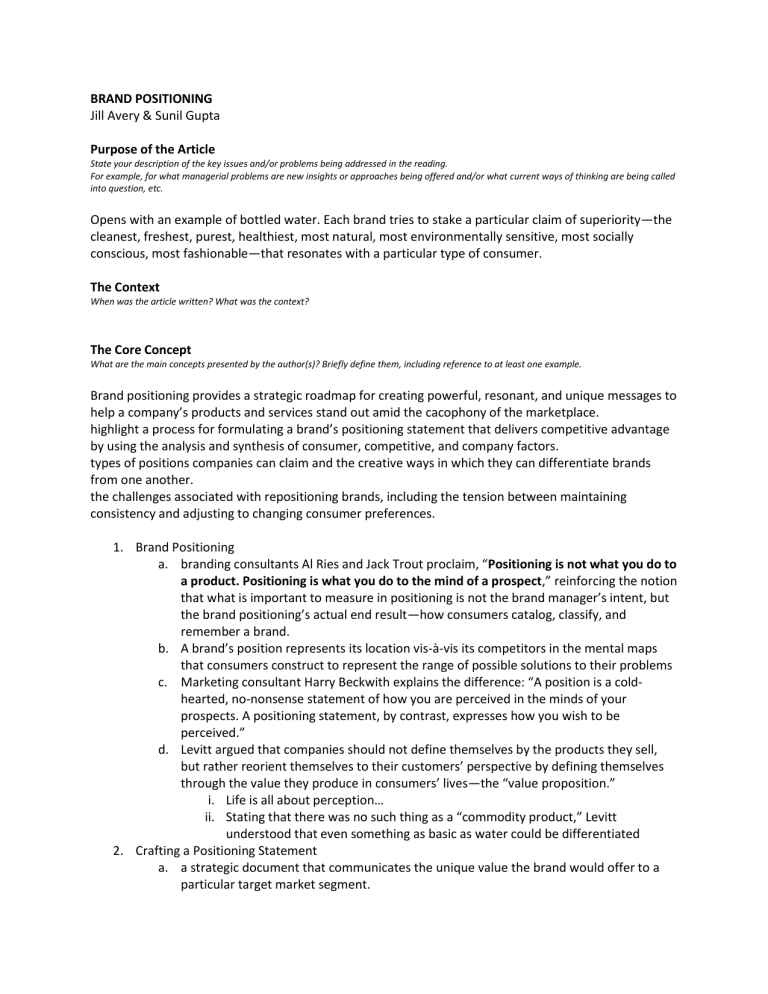
BRAND POSITIONING Jill Avery & Sunil Gupta Purpose of the Article State your description of the key issues and/or problems being addressed in the reading. For example, for what managerial problems are new insights or approaches being offered and/or what current ways of thinking are being called into question, etc. Opens with an example of bottled water. Each brand tries to stake a particular claim of superiority—the cleanest, freshest, purest, healthiest, most natural, most environmentally sensitive, most socially conscious, most fashionable—that resonates with a particular type of consumer. The Context When was the article written? What was the context? The Core Concept What are the main concepts presented by the author(s)? Briefly define them, including reference to at least one example. Brand positioning provides a strategic roadmap for creating powerful, resonant, and unique messages to help a company’s products and services stand out amid the cacophony of the marketplace. highlight a process for formulating a brand’s positioning statement that delivers competitive advantage by using the analysis and synthesis of consumer, competitive, and company factors. types of positions companies can claim and the creative ways in which they can differentiate brands from one another. the challenges associated with repositioning brands, including the tension between maintaining consistency and adjusting to changing consumer preferences. 1. Brand Positioning a. branding consultants Al Ries and Jack Trout proclaim, “Positioning is not what you do to a product. Positioning is what you do to the mind of a prospect,” reinforcing the notion that what is important to measure in positioning is not the brand manager’s intent, but the brand positioning’s actual end result—how consumers catalog, classify, and remember a brand. b. A brand’s position represents its location vis-à-vis its competitors in the mental maps that consumers construct to represent the range of possible solutions to their problems c. Marketing consultant Harry Beckwith explains the difference: “A position is a coldhearted, no-nonsense statement of how you are perceived in the minds of your prospects. A positioning statement, by contrast, expresses how you wish to be perceived.” d. Levitt argued that companies should not define themselves by the products they sell, but rather reorient themselves to their customers’ perspective by defining themselves through the value they produce in consumers’ lives—the “value proposition.” i. Life is all about perception… ii. Stating that there was no such thing as a “commodity product,” Levitt understood that even something as basic as water could be differentiated 2. Crafting a Positioning Statement a. a strategic document that communicates the unique value the brand would offer to a particular target market segment. b. Positioning statements distill the brand’s value proposition into a compelling answer to the all-important question, “Why should I buy?” c. positioning statements are strategic in nature, developed for an internal managerial audience rather than an external consumer audience. d. Positioning statements contain four essential components: i. For whom, for when, for where? 1. outline a particular type of person, a particular usage situation, and/or a particular usage location. ii. What value? 1. A simple, straightforward description of the unique value claim the brand offers, written from the consumer’s viewpoint. This will become the thing for which the brand is known. 2. There are four types of value that customers can derive from a product or service: a. economic value, b. functional value, c. experiential value, d. and/or social value. iii. Why and how? 1. Evidence that provides consumers with reasons to believe the brand’s claims a. Examples; scientific and technological data, consumer testimonials, celebrity or expert endoresements, independent agency seals of approval. iv. Relative to whom? 1. An explicit description of the competitive set in which the brand classifies itself and the alternatives consumers may be considering. v. The four components of positioning statements can be summarized in this general format: 1. For [target market], Brand X is the only brand among all [competitive set] that [unique value claim] because [reasons to believe]. 3. Staking Out a Unique Selling proposition a. Brand managers should craft positioning statements to focus on a single, most important claim that distinguishes the product from the competition, rather than to include a laundry list of all of the attributes, benefits, and values offered by the brand. b. First devised by advertising pioneer Rosser Reeves, a unique selling proposition (USP) is a type of value claim that offers a prospective customer a specific, unique, and superior reason to purchase a product. i. Despite your USP, your product has to be actually better than its competitors, because although a clever USP will get your sales, customer loyalty will falter if the product doesn’t live up to it expectations. c. successful brand positions were those that struck a human chord. “Nothing is so powerful as an insight into human nature, what compulsions drive a man, what instincts dominate his action,” proclaimed Bernbach. Their positioning strategies used creativity, wit, intelligence, and storytelling to capture consumers’ imaginations. d. Ex: Absolut Vodka i. the brand has earned a place as one of the best-selling liquor brands of all time, all based on a value claim that focused on selling an image and a link to contemporary art and culture, rather than a rational reason to buy the product. 4. The Three C’s Model a. Choosing whether to use a rational or emotional positioning appeal requires insight into three interacting factors: how the firm’s target customers choose and use the product; how the firm’s competitors use rational versus emotional appeals; and how the firm’s own brands and other assets can support the positioning statement. b. i. Consumer Analysis 1. Creating Relevance a. Strong value claims should be relevant to consumers, addressing their fundamental needs or the jobs that they need the product or service to accomplish. b. Because each target market finds relevance in a different product attribute, a marketer’s choice greatly shapes the type of value claim being offered to prospective customers. 2. Creating Resonance a. providing them with a narrative that feels personally meaningful i. feature or attribute-based claims that focus on a special feature, ingredient, or capability of the product or service ii. benefit-based; claims that focus on the specific benefits customers receive from using the product or service iii. value-based; claims that focus on helping consumers achieve the values they hold to be important b. laddering up from feature-based to benefit-based to valuebased claims can increase brand resonance i. ii. Resonant value claims address consumers’ deep-seated needs. They offer the meaning required for living in consumers’ unique cultural space and time 1. This is some deep psychological shit right here iii. At any time, in any culture, certain dominant ideologies serve as the guiding principles for living an aspirational life. However this often changes and creates contradictions of trendy ideologies 1. For example, Harley-Davidson achieved iconic status by positioning its motorcycles as an antidote to the tedium and lack of adventure that comes with being an upstanding citizen and professional. c. Being Realistic i. Offering specific evidence to support a claim provides consumers with reasons to believe it. ii. Procter & Gamble, the manufacturer of world-leading brands such as Tide, Pampers, Gillette, Crest, Olay, and Bounty, has historically used physical demonstrations in its advertising to support its value claims. Think side by side comparison ads. ii. Competitive Analysis- managers can zeroin on particular value claims of the product or service that are distinctive, defensible, and durable vis-à-vis the competition. 1. Being Distinctive a. Jerry Garcia, founder and lead guitarist of the Grateful Dead rock band, once said, “You do not merely want to be considered just the best of the best. You want to be considered the only ones who do what you do.” b. Products and services generally contain three types of attributes that can be transformed into value claims and leveraged for brand positioning: unique attributes, shared attributes, and irrelevant attributes. c. Points of parity are those product or brand attributes, benefits, or values that are shared across competitors. i. These often represent “must-haves”—features that consumer’s demand before they are willing to consider a product or service for purchase. ii. Talking about these features does not usually make a brand stand out, but failing to reassure consumers about such necessities may cause the consumer to not even consider the brand d. Points of difference are those product or brand attributes, benefits, or values that are unique to a particular competitor. i. To command a price premium over its competitors, a brand’s position must contain a point of difference that is large enough to justify the higher cost to the consumer. ii. Two types of strategies allow managers to leverage their product or service’s points of difference: 1. Vertical positioning highlights attributes that are shared among brands, but stresses a particular brand’s superior performance on those attributes, using words such as smaller, faster, and cheaper to delineate a natural pecking order. 2. horizontal positioning involves adding new attributes, benefits, or values to attract customers. iii. Some companies go so far as to trademark an irrelevant ingredient so that they can use it as a point of difference. iv. the benefits of meaningless differentiation held up even after consumers were told that the attribute did not contribute anything to the product’s performance. The sheer fact of the difference was enough to make the product valuable to consumers. 2. Perceptual Mapping a. visual image of consumers’ mental landscapes. b. Consumers are asked to compare and contrast sets of brands across a set of attributes; then their answers are used to map the spatial differences among brands. Using these distances, marketers can construct a two-dimensional or multidimensional graphical representation of how consumers perceive the brands in a product category. c. The market research agency The Nielsen Company has developed a tool that scans the web for consumer conversations about brands and then plots the words and phrases that most closely correlate with a particular brand. Brand association maps, a type of perceptual map, are generated from the data, where the proximity of words to each other indicates their statistical correlation. i. ii. A visual inspection of a perceptual map allows managers to identify gaps in the market, represented by pieces of mental real estate to which no brand has yet laid claim. iii. also allows managers to understand how crowded their own section is, which indicates how fiercely they will need to compete for consumers’ attention iv. enables managers to understand how close or far away competitors’ positions are, and identify which rivals may encroach on their territory 1. 3. Choosing Defensible Terrain a. Patents and trademarks can increase the defensibility of a product’s value claims b. Brands can stake defensible claims by being first to be positioned in a certain area, becoming “the original.” c. brands can stake defensible claims by outspending competitors to speak with the loudest voice 4. Being Durable a. develop positioning statements that will stand the test of time. Durable brand positions, whose appeal lasts over prolonged periods of time, provide continuity to a brand. b. Jean-Noël Kapferer warns that “a brand will only survive in the long term if it can demonstrate its relevance with regard to the latest changing needs of a market, which is in a state of constant evolution.” iii. Company Analysis- allows managers to identify value claims that are feasible, favorable, and faithful to the company. 1. Being Feasible a. Managers should assess the feasibility of various positioning statements to determine which ones the company can actually deliver against in its everyday practices, across every marketing decisions and the 4 P s. 2. Being Favorable a. For a brand’s positioning to become firmly anchored in the minds of consumers, the company must create a direct and reinforcing link between what it says and what it does. b. Living a particular positioning statement may require operational changes, organizational culture changes, staff retraining, and investment in new areas—all of which add costs. c. Assessing the profitability differences between various positions allows managers to see their differential value to the company and to choose the one that is most favorable. 3. Being Faithful a. An authentic brand demonstrates genuineness in the brand’s claimed position; its messaging, assertions and behaviors are all supportive and aligned b. Today’s consumers, linked together via social media, are quick to call out hypocritical companies who claim one thing in their advertising, but do another in practice c. In today’s world, a brand’s position is often co-created, with its owner, its customers, and other cultural influences working together to generate meaning that differentiates the brand from its competitors. i. 5. Brand Repositioning a. As markets change, or as unanticipated events occur, a company may need to reposition its brand. i. PepsiCo has repositioned its brand four times over its life. ii. BP’s positioning crisis. After realizing that BP did not in fact uphold it proclaimed environmental concerns, one of its four primary values, the consumers went nuts on it with parodies and taglines. 1. A decade of careful brand positioning was undone in an instant. 2. Subsequently BP changed its positioning statement to “We are committed to making a real difference in providing better energy that is needed today and in the changing world of tomorrow” b. Balancing Consistency and Change i. The four components of the positioning statement point the way: 1. For whom, for when, for where? a. Changing the target market, expanding the usage situation, or finding new places where consumers can purchase or consume the product can often be a way to increase sales. b. Ex: Arm & Hammer’s expansion beyond baking soda 2. What value? a. Most repositioning efforts involve adding new value claims to resonate with changing consumer needs. Managers need to be careful that new claims do not conflict with or undermine the brand’s existing meaning, but rather build on it. 3. Why and How? a. New-product development efforts often yield improved products and services. A brand repositioning can leave the fundamental value claim in place, but offer more persuasive evidence through the inclusion of a new ingredient or upgraded feature 4. Relative to whom? a. Sometimes brand repositioning involves comparing the product or service to a new set of competitors. Here, the brand’s managers redefine the playing field c. Repositioning an Identity Brand i. Managers must be especially careful when repositioning involves an identity brand. Identity brands allow consumers to create and recreate themselves by communicating important things about their masculinity, femininity, social class and status, level of intelligence, personal wealth, cultural capital, and other aspirational attributes. 1. in the music world, indie bands are often accused by their fans of “selling out” to the mainstream when they reposition their music to appeal to larger audiences. ii. some marketers turn to gender bending, a strategy for repositioning a brand that has historically targeted one gender to attract the other. 1. This can backfire, as it did when Porsche released the Cayenne SUV. a. Male Porsche owners felt betrayed; in an online post, one wrote, “The Cayenne makes me feel like my favorite jazz record shop has decided to carry Britney Spears records.” iii. repositioning an identity brand can be dangerous and can play out in a number of negative ways: 1. Existing consumers will leave the brand because it is no longer communicating the identity they wish to present 2. Existing consumers will fight against the brand’s repositioning by cocreating their own meaning for it, thereby changing its position in the minds of other consumers 3. Existing customers will stay with the brand, but devalue it due to its loss of identity signaling power 4. New customers will not be attracted to the repositioned brand because the memory trace of the old brand positioning is too strong and unappealing. The Central Message of the Reading What is the author(s) suggesting as a new way (or ways) of approaching managerial problems and/or thinking about marketing? That is, what are the important takeaways from this reading? Do you agree with them? Why or why not? Addresses the principles of brand positioning: the art of staking out a particular piece of mental real estate for a brand in the consumer’s mind by crafting and communicating a differentiated positioning statement. When it comes to brand positioning, most managers approach the task with a war mentality, thinking about the competitors they must fight to win the “mental real estate” in consumers’ minds. But the real key to successful brand positioning is to find ways to seamlessly fit into consumers’ lives, rather than conquer their minds. It is less about planting a flag and more about paying attention, perceiving, and persuading. It is less about a company and what it wants to achieve and more about its consumers and the jobs they need to have done. It is less about the product and its features and more about how the various aspects of the product or service enhance the daily lives of consumers. Managerial Implications What implications does this reading have for management? That is, how could you as a manager use what you learn from the reading and/or what kinds of suggestions could you as a consultant offer to managers based on what you have learned? Cultural branding is tricky, however. Brands that are culturally resonant today will likely be obsolete tomorrow. Their appeal will rise and fall. Their managers must proactively scan the social, cultural, economic, and competitive environments to sense when tides might be changing, so that they can reposition their brands to bridge new cracks that are forming. Think Apple’s “1984” commercial. As Theodore Levitt reminds us, “Nobody wants to hear that a perfume is a complex concoction of extracts from the lining of the mollusk and urine from the civet cat. . . . As with many purely utilitarian products, people seek not just what they deliver operationally but also (perhaps especially) what they promise emotionally or suggest symbolically.” Marketers develop strong brand positions by looking outward—by understanding consumers so deeply that they can intuitively understand which brand features support the values that consumers hold dear. Marketers also need to understand competitors and identify the possibilities they leave undeveloped— gaps that need to be filled. Most important, marketers develop brand positions by understanding the product technologies at their disposal to create a competitive advantage and how far the company’s employees can go to deliver a differentiated experience. It means knowing the company’s vision and what the company is capable of being to its customers. Supplemental Reading 1. Positioning Differently a. Consumer researcher Youngme Moon instead recommends that managers break out of unprofitable positioning patterns by considering three unique positioning strategies i. Reverse positioning 1. Sometimes brands succeed by stripping away the expected points of parity in their product category and offering consumers something less, and, at the same time, something more in their positioning statements a. Ex: JetBlue ii. Breakaway Positioning 1. When brands find themselves stuck in low-opportunity product categories, breakaway positioning provides a way to escape by leaping into a new category. a. Ex: Swatch iii. Stealth Positioning 1. Sometimes product or service categories become tainted. Consumers become wary to purchase products in categories where they have previously been disappointed by unsatisfactory performance or intimidated by the technical expertise required. State at least one question about the article to discuss in class
